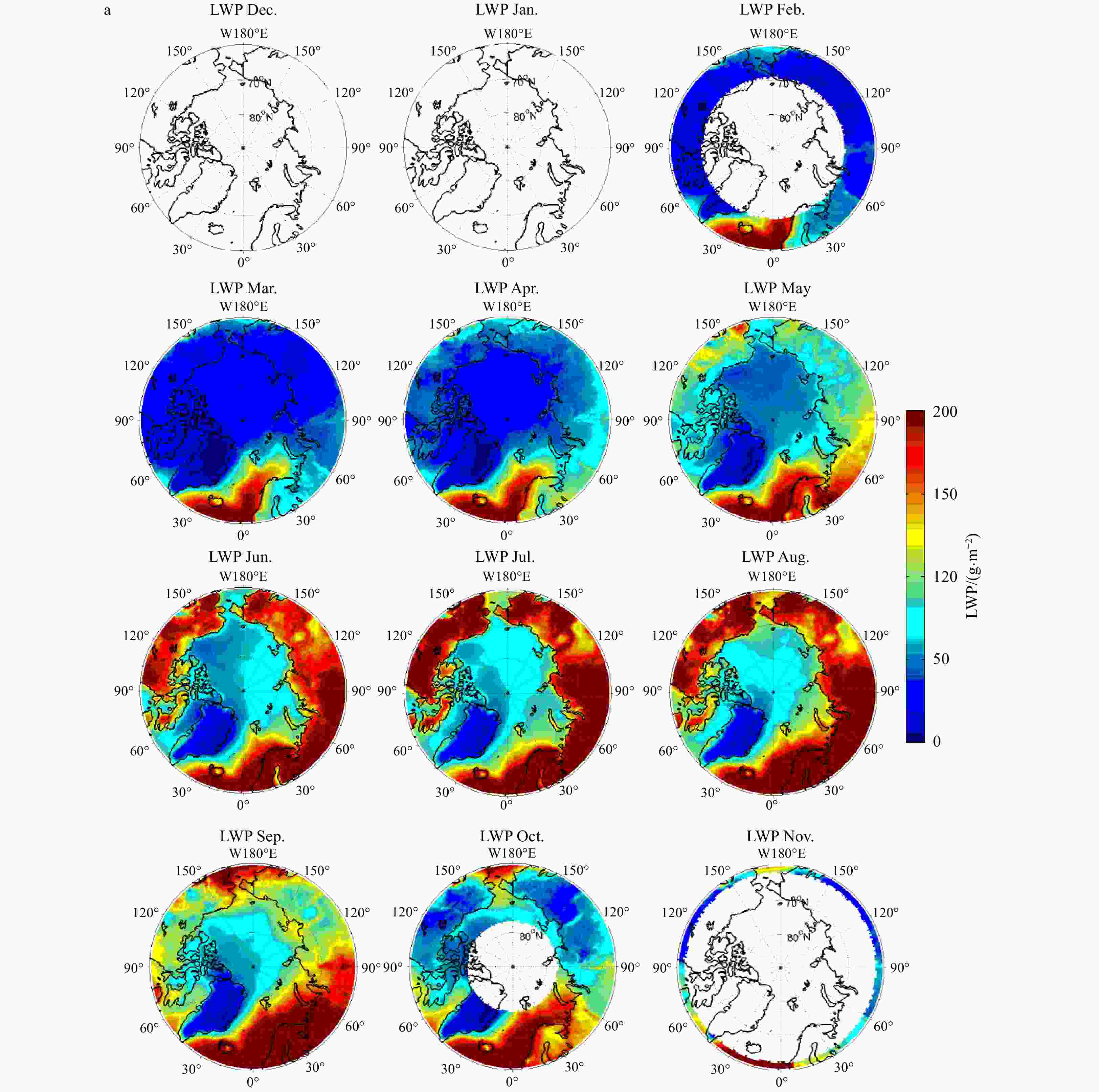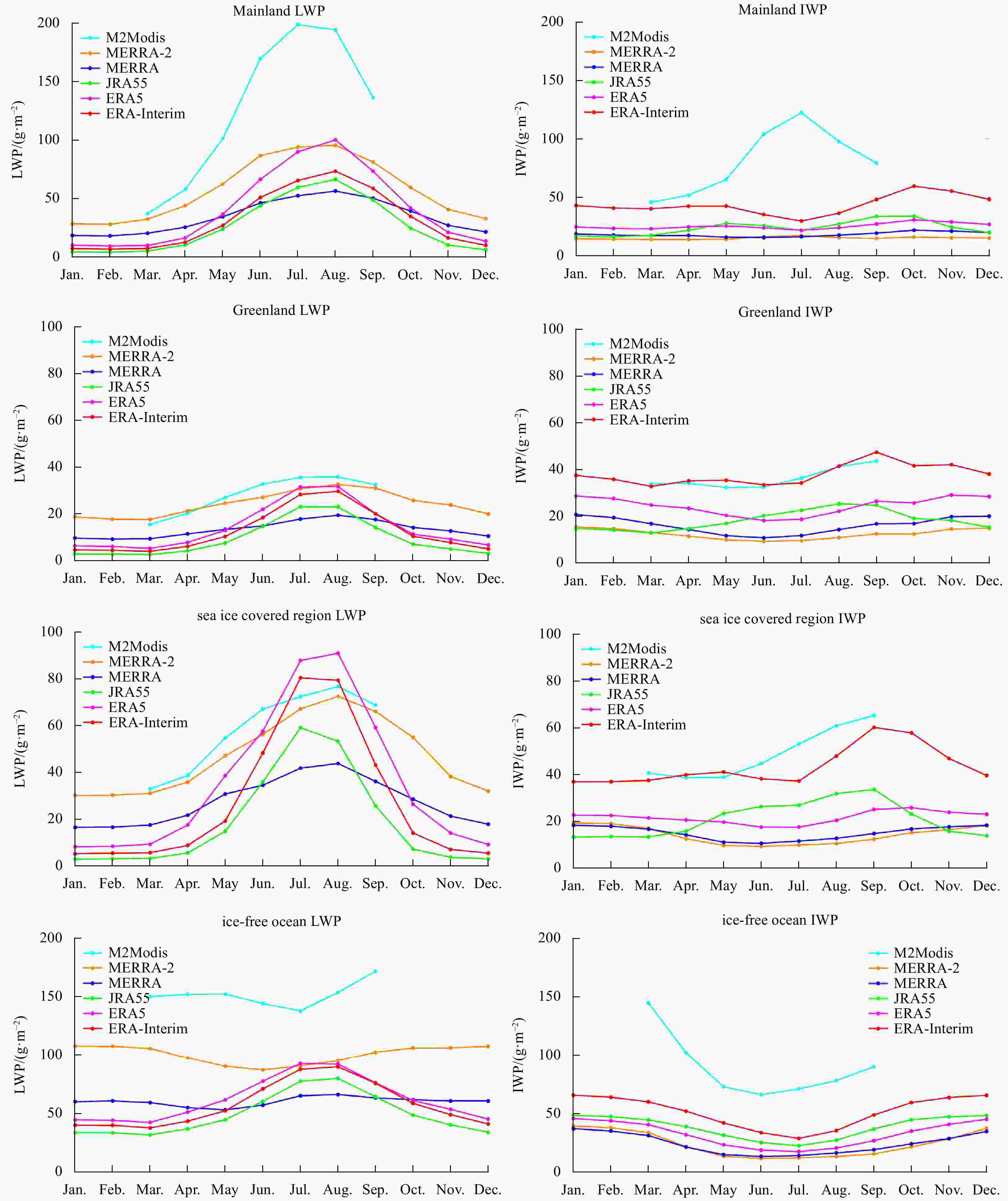-
Abstract: The role of Arctic clouds in the recent rapid Arctic warming has attracted much attention. However, Arctic cloud water paths (CWPs) from reanalysis datasets have not been well evaluated. This study evaluated the CWPs as well as LWPs (cloud liquid water paths) and IWPs (cloud ice water paths) from five reanalysis datasets (MERRA-2, MERRA, ERA-Interim, JRA-55, and ERA5) against the COSP (Cloud Feedback Model Intercomparison Project Observations Simulator Package) output for MODIS from the MERRA-2 CSP (COSP satellite simulator) collection (defined as M2Modis in short). Averaged over 1980–2015 and over the Arctic region (north of 60°N), the mean CWPs of these five datasets range from 49.5 g/m2 (MERRA) to 82.7 g/m2 (ERA-Interim), much smaller than that from M2Modis (140.0 g/m2). However, the spatial distributions of CWPs, show similar patterns among these reanalyses, with relatively small values over Greenland and large values over the North Atlantic. Consistent with M2Modis, these reanalyses show larger LWPs than IWPs, except for ERA-Interim. However, MERRA-2 and MERRA underestimate the ratio of IWPs to CWPs over the entire Arctic, while ERA-Interim and JRA-55 overestimate this ratio. ERA5 shows the best performance in terms of the ratio of IWPs to CWPs. All datasets exhibit larger CWPs and LWPs in summer than in winter. For M2Modis, IWPs hold seasonal variation similar with LWPs over the land but opposite over the ocean. Following the Arctic warming, the trends in LWPs and IWPs during 1980~2015 show that LWPs increase and IWPs decrease across all datasets, although not statistically significant. Correlation analysis suggests that all datasets have similar interannual variability. The study further found that the inclusion of re-evaporation processes increases the humidity in the atmosphere over the land and that a more realistic liquid/ice phase can be obtained by independently treating the liquid and ice water contents.
-
Key words:
- Arctic /
- clouds /
- cloud water paths (CWPs) /
- reanalysis evaluation
-
Table 1. Datasets used in this study
Variable ERA5 ERA-Interim JRA-55 MERRA-2 MERRA M2Modis Institution/project ECMWF ECMWF JMA NASA-GSFC NASA-GSFC NASA-GSFC/CFMIP COSP Resolution (lon. × lat.) 0.25°×0.25° 0.75°×0.75° 1.25°×1.25° 0.625°×0.500° 0.66°×0.50° 0.625°×0.500° Temporal range Jan. 1979 to present Jan. 1979 to present Jan. 1958 to present Jan. 1980 to present Jan. 1979 to Feb. 2016 Jan. 1980 to present Cloud property parameterizations Tiedtke (1993) Tiedtke (1993) Sommeria and Deardorff (1977) Bacmeister et al. (2006) Bacmeister et al. (2006) Note: See Section 2.5 for more details of M2Modis. Table 2. Means and standard deviations of LWPs, IWPs, and CWPs and the ratios of average IWPs to average CWPs over the Arctic
Reanalysis datasets LWP/ (g·m–2) IWP/ (g·m–2) CWP/ (g·m–2) $\dfrac{\rm{IWP}}{\rm{CWP}} $/% Mean STD Mean STD Mean STD M2Modis 80.9 40.7 59.1 29.8 140.0 62.6 42 MERRA-2 58.8 24.0 13.1 5.5 71.8 25.8 18 MERRA 35.0 14.9 14.6 5.8 49.5 17.3 29 ERA5 49.0 31 22.4 8.5 71.4 35.6 31 ERA-Interim 39.6 31.0 43.1 16.3 82.7 37.9 53 JRA-55 29.7 23.7 25.1 11.6 54.8 31.1 46 Table 3. Linear trends in M2Modis and five reanalysis datasets, as well as correlation coefficients using original and detrended time series (in brackets) between M2Modis and each reanalysis dataset
Reanalysis datasets CWP LWP IWP Trend/(g·m–2·century–1) Corr/10–2 Trend/(g·m–2·century–1) Corr/10–2 Trend/(g·m–2·century–1) Corr/10–2 M2Modis 22 42 –20 MERRA-2 8 94(91) 18 95(83) –9 86(87) MERRA 6 67(61) 11 86(68) –5 84(76) ERA5 5 60(52) 8 57(33) –2 74(73) ERA–I 9 74(68) 17 84(62) –7 82(75) JRA–55 13 69(55) 12 84(60) –8 40(57) Note: Red color means passing the 95% significance test. -
[1] Bacmeister J T, Suarez M J, Robertson F R. 2006. Rain reevaporation, boundary layer-convection interactions, and pacific rainfall patterns in an AGCM. Journal of the Atmospheric Sciences, 63(12): 3383–3403. doi: 10.1175/JAS3791.1 [2] Bosilovich M G, Lucchesi R, Suarez M. 2016. MERRA-2: File specification. GMAO Office Note No. 9 (Version 1.1). Greenbelt, Maryland: GMAO [3] Chernokulsky A, Mokhov I I. 2012. Climatology of total cloudiness in the arctic: an intercomparison of observations and reanalyses. Advances in Meteorology, 2012: 542093. doi: 10.1155/2012/542093 [4] Chou M D, Suarez M J, Liang X Z, et al. 2001. A thermal infrared radiation parameterization for atmospheric studies. Technical Report Series on Global Modeling and Data Assimilation, NASA/TM-2001-104606, Vol. 19. Greenbelt, MD: Goddard Space Flight Center [5] Curry J A, Rossow W B, Randall D, et al. 1996. Overview of arctic cloud and radiation characteristics. Journal of Climate, 9(8): 1731–1764. doi: 10.1175/1520-0442(1996)009<1731:OOACAR>2.0.CO;2 [6] Dee D P, Uppala S M, Simmons A J, et al. 2011. The ERA-Interim reanalysis: Configuration and performance of the data assimilation system. Quarterly Journal of the Royal Meteorological Society, 137(656): 553–597. doi: 10.1002/qj.828 [7] Dethloff K, Handorf D, Jaiser R, et al. 2019. Dynamical mechanisms of Arctic amplification. Annals of the New York Academy of Sciences, 1436(1): 184–194. doi: 10.1111/nyas.13698 [8] Ebert E E, Curry J A. 1992. A parameterization of ice cloud optical properties for climate models. Journal of Geophysical Research: Atmospheres, 97(D4): 3831–3836. doi: 10.1029/91JD02472 [9] ECMWF. 2010. IFS Documentation-CY36R1 Part IV: Physical Processes[J]. Reading, England: ECMWF, https://www.ecmwf.int/node/9233 [2010-1-26/2019-11-3], doi: 10.21957/2loi3bxcz [10] English J M, Kay J E, Gettelman A, et al. 2014. Contributions of clouds, surface albedos, and mixed-phase ice nucleation schemes to Arctic radiation biases in CAM5. Journal of Climate, 27(13): 5174–5197. doi: 10.1175/JCLI-D-13-00608.1 [11] Fouquart Y. 1988. Radiative transfer in climate models. In: Schlesinger M E, ed. Physically-Based Modelling and Simulation of Climate and Climatic Change. Dordrecht: Springer, 223–283 [12] Fu Q, Yang P, Sun W B. 1998. An accurate parameterization of the infrared radiative properties of cirrus clouds for climate models. Journal of Climate, 11(9): 2223–2237. doi: 10.1175/1520-0442(1998)011<2223:AAPOTI>2.0.CO;2 [13] Gelaro R, McCarty W, Suárez M J, et al. 2017. The modern-era retrospective analysis for research and applications, version 2 (MERRA-2). Journal of Climate, 30(14): 5419–5454. doi: 10.1175/JCLI-D-16-0758.1 [14] Geleyn J F, Hollingsworth A. 1979. An economical analytical method for the computation of the interaction between scattering and line absorption of radiation. Contrib to Atmospheric Physics, 52: 1–16 [15] Hersbach H, Bell B, Berrisford P, et al. 2020. The ERA5 global reanalysis. Quarterly Journal of the Royal Meteorological Society, 146(730): 1999–2049. doi: 10.1002/qj.3803 [16] Huang Y Y, Dong X Q, Xi B K, et al. 2017. Quantifying the uncertainties of reanalyzed Arctic cloud and radiation properties using satellite surface observations. Journal of Climate, 30(19): 8007–8029. doi: 10.1175/JCLI-D-16-0722.1 [17] Johansson E, Devasthale A, Tjernström M, et al. 2017. Response of the lower troposphere to moisture intrusions into the Arctic. Geophysical Research Letters, 44(5): 2527–2536. doi: 10.1002/2017GL072687 [18] Japan Meteorological Agency. 2019. Outline of the operational numerical weather prediction at the Japan Meteorological Agency. In: WMO Technical Progress Report on the Global Data-processing and Forecasting System and Numerical Weather Prediction. Japan: JMA, http://www.jma.go.jp/jma/jma-eng/jma-center/nwp/outline2019-nwp/index.htm [2019-3-30/2019-11-3] [19] Kay J E, L’Ecuyer T, Chepfer H, et al. 2016. Recent advances in arctic cloud and climate research. Current Climate Change Reports, 2(4): 159–169. doi: 10.1007/s40641-016-0051-9 [20] Kobayashi S, Ota Y, Harada Y, et al. 2015. The JRA-55 reanalysis: general specifications and basic characteristics. Journal of the Meteorological Society of Japan Ser II, 93(1): 5–48. doi: 10.2151/jmsj.2015-001 [21] Kitagawa H, Murai S. 2006. A revised radiation scheme for cloud treatments in the Japan Meteorological Agency Global Spectral Model. CAS/JSC WGNE Res. Activ Atmos Oceanic Modell, 36: 17–18 [22] Lenaerts J T M, Van Tricht K, Lhermitte S, et al. 2017. Polar clouds and radiation in satellite observations, reanalyses, and climate models. Geophysical Research Letters, 44(7): 3355–3364. doi: 10.1002/2016GL072242 [23] Li Z X, Le Treut H. 1992. Cloud-radiation feedbacks in a general circulation model and their dependence on cloud modelling assumptions. Climate Dynamics, 7(3): 133–139. doi: 10.1007/BF00211155 [24] Liu Y H, Key J R. 2016. Assessment of arctic cloud cover anomalies in atmospheric reanalysis products using satellite data. Journal of Climate, 26(17): 6065–6083. doi: 10.1175/JCLI-D-15-0861.1 [25] Liu Y H, Key J R, Vavrus S, et al. 2018. Time evolution of the cloud response to moisture intrusions into the Arctic during winter. Journal of Climate, 31(22): 9389–9405. doi: 10.1175/JCLI-D-17-0896.1 [26] Martin G M, Johnson D W, Spice A. 1994. The measurement and parameterization of effective radius of droplets in warm stratocumulus clouds. Journal of the Atmospheric Sciences, 51(13): 1823–1842. doi: 10.1175/1520-0469(1994)051<1823:TMAPOE>2.0.CO;2 [27] Molod A, Takacs L, Suarez M, et al. 2015. Development of the GEOS-5 atmospheric general circulation model: evolution from MERRA to MERRA2. Geoscientific Model Development, 8(5): 1339–1356. doi: 10.5194/gmd-8-1339-2015 [28] Moorthi S, Suarez M J. 1992. Relaxed arakawa-schubert. a parameterization of moist convection for general circulation models. Monthly Weather Review, 120(6): 978–1002. doi: 10.1175/1520-0493(1992)120<0978:RASAPO>2.0.CO;2 [29] Ou S C, Liou K N. 1995. Ice microphysics and climatic temperature feedback. Atmospheric Research, 35(2–4): 127–138 [30] Qiu S Y, Dong X Q, Xi B K, et al. 2015. Characterizing Arctic mixed-phase cloud structure and its relationship with humidity and temperature inversion using ARM NSA observations. Journal of Geophysical Research: Atmospheres, 120(15): 7737–7746. doi: 10.1002/2014JD023022 [31] Räisänen P. 1998. Effective longwave cloud fraction and maximum-random overlap of clouds: A problem and a solution. Monthly Weather Review, 126(12): 3336–3340. doi: 10.1175/1520-0493(1998)126<3336:ELCFAM>2.0.CO;2 [32] Rienecker M M, Suarez M J, Gelaro R, et al. 2011. MERRA: NASA’s modern-era retrospective analysis for research and applications. Journal of Climate, 24(14): 3624–3648. doi: 10.1175/JCLI-D-11-00015.1 [33] Rozenhaimer M S, Barton N, Redemann J, et al. 2018. Bias and sensitivity of boundary layer clouds and surface radiative fluxes in MERRA-2 and airborne observations over the Beaufort Sea during the ARISE campaign. Journal of Geophysical Research: Atmospheres, 123(12): 6565–6580. doi: 10.1029/2018JD028349 [34] Savijärvi H, Räisänen P. 1998. Long-wave optical properties of water clouds and rain. Tellus A, 50(1): 1–11. doi: 10.3402/tellusb.v50i1.16018 [35] Screen J A, Simmonds I. 2010. The central role of diminishing sea ice in recent Arctic temperature amplification. Nature, 464(7293): 1334–1337. doi: 10.1038/nature09051 [36] Serreze M C, Barry R G. 2011. Processes and impacts of Arctic amplification: a research synthesis. Global and Planetary Change, 77(1–2): 85–96. doi: 10.1016/j.gloplacha.2011.03.004 [37] Slingo A. 1989. A GCM parameterization for the shortwave radiative properties of water clouds. Journal of the Atmospheric Sciences, 46(10): 1419–1427. doi: 10.1175/1520-0469(1989)046<1419:AGPFTS>2.0.CO;2 [38] Sommeria G, Deardorff J W. 1977. Subgrid-scale condensation in models of nonprecipitating clouds. Journal of the Atmospheric Sciences, 34(2): 344–355. doi: 10.1175/1520-0469(1977)034<0344:SSCIMO>2.0.CO;2 [39] Tan I, Storelvmo T. 2019. Evidence of strong contributions from mixed-phase clouds to arctic climate change. Geophysical Research Letters, 46(5): 2894–2902. doi: 10.1029/2018GL081871 [40] Taylor P C, Boeke R C, Li Y, et al. 2019. Arctic cloud annual cycle biases in climate models. Atmospheric Chemistry and Physics, 19(13): 8759–8782. doi: 10.5194/acp-19-8759-2019 [41] Tiedtke M. 1993. Representation of clouds in large-scale models. Monthly Weather Review, 121(11): 3040–3061. doi: 10.1175/1520-0493(1993)121<3040:ROCILS>2.0.CO;2 [42] Walsh J E, Chapman W L, Portis D H. 2009. Arctic cloud fraction and radiative fluxes in atmospheric reanalyses. Journal of Climate, 22(9): 2316–2334. doi: 10.1175/2008JCLI2213.1 [43] Wang Z M, Zhang X D, Guan Z Y, et al. 2015. An atmospheric origin of the multi-decadal bipolar seesaw. Scientific Reports, 5: 8909. doi: 10.1038/srep08909 [44] Washington W M, Williamson D L. 1977. A description of the NCAR global circulation models. National Center for Atmospheric Research Ncar Koha Opencat, 17: 111–172, doi: 10.1016/b978-0-12-460817-7.50008-2 -





 下载:
下载:












